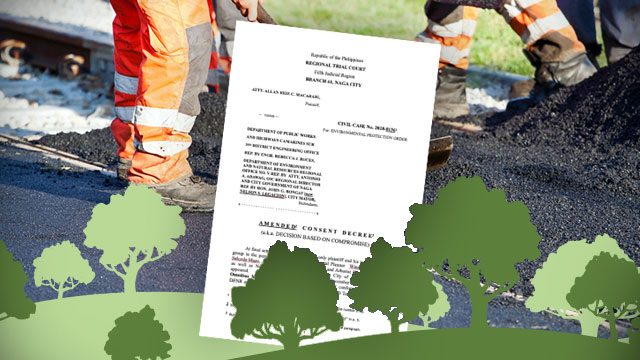SUMMARY
This is AI generated summarization, which may have errors. For context, always refer to the full article.

MANILA, Philippines – A Naga City court in has approved a compromise agreement between an environmental advocate and the government that would spare 15 trees from a road-widening project along the San Felipe-Panicuason Road.
Naga City Regional Trial Court (RTC) Branch 61 Judge Soliman Santos Jr approved the compromise agreement on December 16, 2019, a copy of which was provided to Rappler on Monday, January 13.
Santos approved the agreement between plaintiff lawyer Allan Reiz Macaraig and the respondent – the Naga City local government, including the mayor, and the local Department of Public Works and Highways (DPWH) and Department of Environment and National Resources (DENR).
There were 98 trees set for cutting for the road widening project, but by the time the parties reached a compromise, there were only 26 that were left uncut.
Of the 26, the parties settled to spare 15 trees: 4 Indian trees, 3 mango trees, 1 agojo tree, 1 santol tree, 1 talisay tree, 1 pine tree, 1 avocado tree, 1 mahogany tree, 1 kakawate tree, and 1 unknown tree.
The 15 trees are within the 20-meter road-right-of-way but outside the 15-meter width of the project.
The rest of the uncut trees, numbering 11, within the 15-meter width of the project and will still be cut “for public safety reasons as well as the expeditious completion of the project.”
The judge said, however, that under the compromise agreement, the DPWH “need not cut for now” the 15 trees “thus there is an opening left for them to be cut in the future.”
Any action to cut the 15 trees in the future, the judge said, should be approved by the court first.
“Whatever future cutting of these 15 trees shall require an agreement by the parties and approval by this Court or by some other mutually agreed process, mechanism or forum, discussed further below,” said Judge Santos.
In view of the agreement, the judge also lifted the Temporary Protection Order (TEPO) on the trees that he had issued in September 2018.
The agreement allowed the government to renew its Special Tree Cutting Permit, which does not cover the 15 trees, where parties agreed “not to initiate any action against the renewal or revalidation” of the STCP.
Follow a master plan
The judge also “strongly endorsed” a proposed streetscape master plan which entailed close coordination among government, civic groups, and the court for future projects.
The master plan also required an evaluation of the areas to “identify feasible areas that can already be planted with trees and eventually undertake the planting of trees on such areas.” (READ: Green groups to DPWH: Good road design includes trees)
The proposed master plan was specifically designed for the 1,080-meter portion of the San Felipe-Panicuason Road, but Judge Santos said, “The concept of the Proposed Streetscape Master plan should be feasible for other or future road-widening projects – in order to minimize the loss of trees and also provide for curb and gutter with plant box, bike lane, plant strip, and sidewalk.”
“The point…is that there are technical resources, talents, and perspectives of civil society that can complement those of the concerned government agencies, if there can be avenues of cooperation towards the best possible designs for project plans, especially where there are environmental impacts,” the judge said.
He encouraged stakeholders to discuss environmental plans “at the earliest opportunity” to avoid litigation.
The judge noted that of the 11 trees that are set to be cut, 5 were recommended to be spared by the expert arborist of the environmental groups.
“And so, it is clear that there was give and take by both sides. But it should also be clear that for the plaintiff and other environmental advocates, the conceding of those 5 trees for cutting, despite Arborist Luna’s recommendation that they be retained, is a sacrifice, a tree sacrifice, if you will,” said the judge.
The judge told the government to take notice and strictly adopt masterplans that would spare more trees in the future.
“For them, this sacrifice can only be justified or compensated for by the concerned government agencies giving due and serious consideration to the Proposed Streetscape Masterplan or its concept when it comes to road-construction and road-widening projects, or more precisely and better still the planning and designing thereof,” said the judge.
Civic and environmental groups in various parts of the country have been opposed to road-widening projects done at the expense of centuries-old roadside trees – Rappler.com
Add a comment
How does this make you feel?
There are no comments yet. Add your comment to start the conversation.